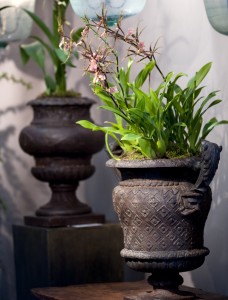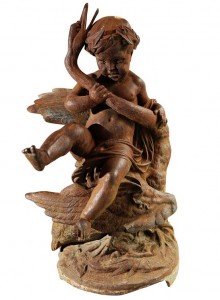Garden Art and Ornaments
Posted in Around the Garden, Programs and Events on April 24 2012, by Sonia Uyterhoeven
 This year is the 20th Anniversary of our Antique Garden Furniture Show. In honor of its celebration, I will review some of the basics for maintaining antique garden ornaments, but my best suggestion is that you stop by the show from April 26 through 28 and talk to the experts. We will have over 30 antique dealers who specialize in garden ornaments, catering to a wide range of tastes and budgets.
This year is the 20th Anniversary of our Antique Garden Furniture Show. In honor of its celebration, I will review some of the basics for maintaining antique garden ornaments, but my best suggestion is that you stop by the show from April 26 through 28 and talk to the experts. We will have over 30 antique dealers who specialize in garden ornaments, catering to a wide range of tastes and budgets.
In anticipation of the show, I have been perusing the library’s collection of books, finding inspiration not only in the traditional tomes filled with marble nymphs and cast iron urns, but from modern design books that suggest repurposing local material.
I have started to construct my dream garden piece by piece. One item that is at the top of my wish list is a 19th century terra cotta oil jar from Italy. It was traditionally used to hold vats of olive oil, but in its modern rendition would make a wonderful focal point in an herbaceous border.
At a close second is a French flower stand from the same time period that has a flat, woven wire basket resting on an ornate cast iron base. It would make an ideal stand for a collection of small pots of herbs or sedums and hens and chicks.
If you are set on classically improving your garden and instantly giving it a sophisticated appeal then the show will provide plenty of inspiration. You will find statues, sundials, finials, urns, obelisks, fountains and high-end garden furniture. Antique furniture and ornaments come in a wide array of material including bronze, lead, cast iron, marble, granite, carved stone, wrought iron, wood and terra cotta.
 All of these garden features need attention paid to maintenance and protection from the winter elements, as with any items that you place in your garden. Terra cotta should either be brought indoors or turned upside down so that water doesn’t collect in it during the winter months. We do this with many of our large terra cotta pots at the NYBG. If you can’t lift the pot or are worried that it will be damaged in the move, think about building a wooden lid for the pot that will seal the opening and prevent moisture from getting inside.
All of these garden features need attention paid to maintenance and protection from the winter elements, as with any items that you place in your garden. Terra cotta should either be brought indoors or turned upside down so that water doesn’t collect in it during the winter months. We do this with many of our large terra cotta pots at the NYBG. If you can’t lift the pot or are worried that it will be damaged in the move, think about building a wooden lid for the pot that will seal the opening and prevent moisture from getting inside.
Cast iron pieces can be protected and prevented from rusting if you apply a few coats of epoxy primer or past wax as a sealant. Clean off the rust with a wire brush before you paint over it. But don’t bother polishing bronze–the patina is actually a protective coating that prevents the metal from corroding, so it is best to leave it untouched. If you have cracks in marble or stone, they can fill with water in the winter and expand. The best thing to do is to cover your ornament with either a traditional wooden sentry box, with tarps, or with breathable polypropylene furniture covers.
If you have a valued antique, then it may be best to hire a professional conservator. Come join us at the Antique Garden Furniture Show from April 26 to April 28 to admire, to dream, and, if you are lucky enough, to purchase.


Thank you for the tip on protecting old iron urns from rusting. Mine aren’t antique, but they are rusting. I’m not sure I’d want to set a wire brush on an antique iron piece, though. For my contemporary ones, I appreciate it. Also enjoyed the tip on dealing with terra cotta to protect them from cracking.
I wish I could make it down to that show because I’m on the search for a very large round pot, copper or concrete, to sit in the middle of my lavender bed.